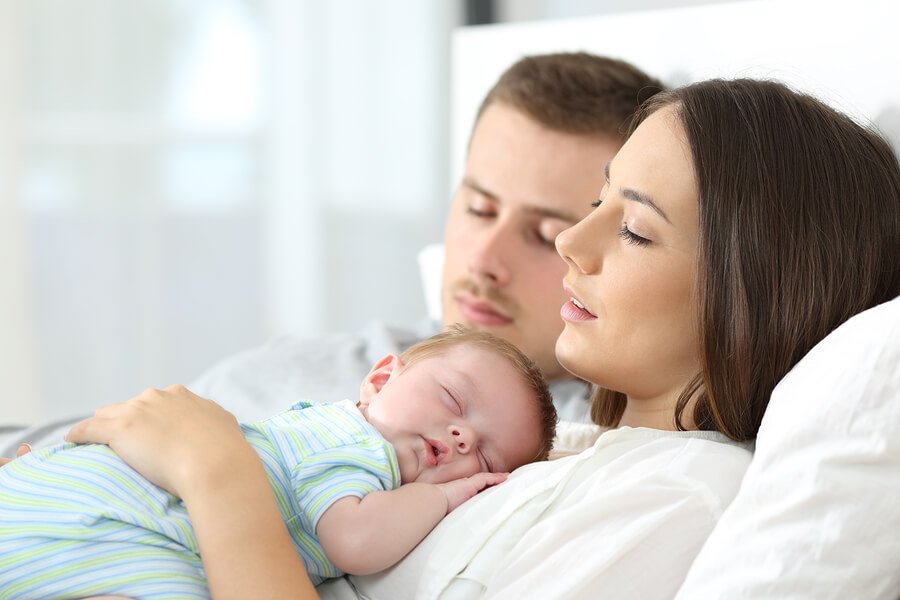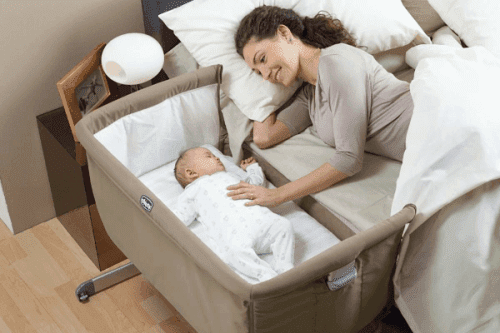Guide to Co-Sleeping Safely

Many parents decide to use this method and sleep with their babies. However, it’s important to know what the experts recommend you take into account. That way, you can sleep safely together without posing any health risks.
There is constant controversy between whether it’s healthy to co-sleep or not. On the one hand, it’s true that it enhances the emotional bond. In addition, it makes breastfeeding much easier.
On the other hand, many people suspect it could be related to sudden infant death syndrome (SIDS). Therefore, experts have decided to sit down to discuss the issue, regardless of whether or not it’s recommended.
Co-sleeping safely
The Breastfeeding Committee of the Spanish Association of Pediatrics (SAP) and the Working Group of Sudden Infant Death of the SAF give us a series of guidelines to take into account. They’ll help you practice safe co-sleeping.
We’ll explain them to you here:
- The surface the baby sleeps on must be firm.
- Don’t have pillows, blankets or stuffed animals around him. This way, you can avoid possible suffocation.
- Always lay the baby on his back. Never place him on his stomach or side.
- Never place the baby on a pillow or water bed.
- Make sure the mattress is attached to the wall. There shouldn’t be any space the baby could fall in or suffocate. The same rules apply for a sidecar crib.
- The baby should never sleep in an armchair. There are lots of spaces they could fall in and get trapped.
- Don’t sleep with him in your arms since he could fall.
- Don’t place anything on his head. This could hinder his breathing.
- Make sure the temperature of the room isn’t too hot. Also, make sure they aren’t too warm in their clothes.

- For the first weeks, the baby should sleep in a sidecar crib or between the wall and the mother. Fathers take more time to get used to their baby’s presence and could crush them with sudden movement. After some time, fathers tend to become more sensitive. Then, the baby can sleep between both parents.
- Smoking during and after pregnancy increases the risk of sudden infant death. In this case, we aren’t only talking about the mother. If either parent smokes, they shouldn’t sleep in the bed with the baby. The smoker can sleep in another room.
- Similarly, using drugs, alcohol or sleeping pills isn’t a good idea. It reduces your ability to react.
- Experts don’t recommend co-sleeping with obese people. They create a larger dent in the mattress, which is dangerous for the baby.
- Experts recommend not sharing the bed with siblings under a year old. They aren’t used to the baby’s movements or their presence in general.
Ways to practice co-sleeping
When we talk about co-sleeping, the first thing that comes to mind is a large bed with everyone sleeping in it. Although it’s true that this is common, there are other alternatives.
On the market, there are sidecar cribs. The side bar is removed and attaches to a side of the bed. This way, they give a little more space and keep the baby close, but it’s a space just for him.

“The surface the baby sleeps on must be firm. Don’t have pillows, blankets or stuffed animals around him. This way, you can avoid possible suffocation.”
There are even people who point out that co-sleeping with a crib next to the bed is also a good option. When babies grow, they can take up an extra mattress next to their parents.
The key is to reach a consensus as a family. Do what you feel comfortable with, making sure to keep your baby safe.
The first months can be difficult, especially for the mother. Therefore, if you decide to sleep with your baby, keep these tips in mind. That way, you can co-sleep safely.
All cited sources were thoroughly reviewed by our team to ensure their quality, reliability, currency, and validity. The bibliography of this article was considered reliable and of academic or scientific accuracy.
- Landa Rivera, L., Díaz-Gómez, M., Gómez Papi, A., Paricio Talayero, J. M., Pallás Alonso, C., Hernández Aguilar, M. T., … & Lasarte Velillas, J. J. (2012). El colecho favorece la práctica de la lactancia materna y no aumenta el riesgo de muerte súbita del lactante: Dormir con los padres. Pediatría Atención Primaria, 14(53), 53-60. http://scielo.isciii.es/pdf/pap/v14n53/revision1.pdf
- Horsley T, Clifford T, Barrowman N, Bennett S, Yasdi F, Sampson M, et al. (2007). Benefits and harms associated with the practice of bed sharing. Arch Pediatr Ado- lesc Med. 2007;161:237-45.
- Martin Martin, R., Sanchez Bayle, M., & Teruel de Francisco, M. C. (2017). El colecho en nuestro medio: estudio de casos y controles en las consultas pediátricas de Atención Primaria. Pediatría Atención Primaria, 19(73), 15-21. http://scielo.isciii.es/scielo.php?script=sci_arttext&pid=S1139-76322017000100003
- Rodríguez Villar, V., Moreno, M., & Navío, C. PRACTICANDO EL COLECHO. ASESORAMIENTO DE LA MATRONA. http://www.trances.es/papers/TCS%2005_3_6.pdf
- Ball, H. L., Hooker, E., & Kelly, P. J. (2000). Parent–infant co‐sleeping: fathers’ roles and perspectives. Infant and Child Development: An International Journal of Research and Practice, 9(2), 67-74. https://onlinelibrary.wiley.com/doi/abs/10.1002/1522-7219(200006)9:2%3C67::AID-ICD209%3E3.0.CO;2-7
This text is provided for informational purposes only and does not replace consultation with a professional. If in doubt, consult your specialist.








